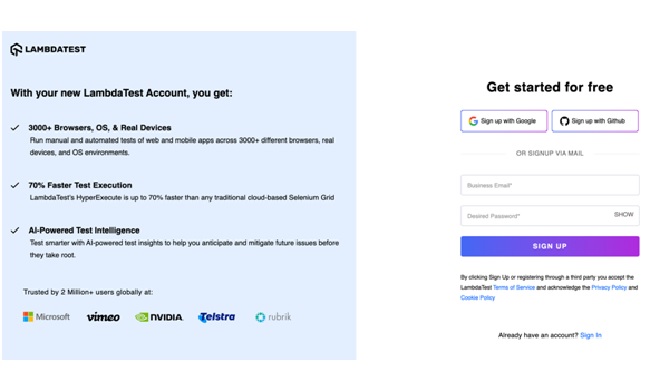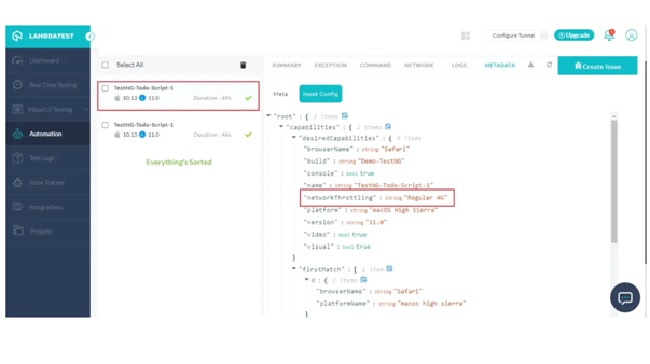Test automation is one of the most efficient ways of verifying the performance of modern applications. This is because, using test automation, the app developers can utilize multiple use case scenarios and conduct the test cases simultaneously.
This becomes even more useful when the developers are working on mobile apps that are subjected to a lot of variations. Some of the common parameters include changes in hardware, Software, physical parameters, and user errors.
Appium automation is an efficient way of verifying the performance of mobile applications based on various device and system configurations. Network throttling is an efficient way of understanding the performance of an application based on various forms of unstable network configurations.
It also allows the application developers to verify the stability of the application irrespective of changes in the user network.
With this article, we will explore the various ways that can help app developers to configure their test automation environment for enabling network throttling.
We will also analyze some of the Tools, best practices, and tips that can help the application developers during the execution of this testing process.
Read Also:
- Archery Olympic Games Tokyo 2020
- A. Yates Olympic Games Tokyo 2020
- A. Peleteiro Olympic Games Tokyo 2020
- A. Sabalenka Olympic Games Tokyo 2020
Importance of Modern Test Automation
Test automation is the process of eliminating human involvement in a test case execution process. Instead, the system will extract the required data from a text file for emulating various forms of human interactions.
Based on these communications, the system will generate a detailed test report showing the usability and stability of the app.
In this context, we will mention that it is possible to make critical changes in the test automation file for customizing their reports as per the requirements of the app project. A few crucial upsides of test automation include:
- It does not rely on human involvement, the application developers can run the automation test cases 24 hours round the clock.
- With the help of automation testing, the application developers can run multiple test instances using parallel testing which uses the concept of a hub that is connected to several nodes. These nodes represent all the elements of a modern application.
- The automation test cases are highly reusable and easy to maintain. So, the app developers can reuse the existing automation test data in future app development projects.
- Automation testing should be considered a long-term investment as it profits the company in the long run. This is because automation testing will remove the expenses that are related to maintaining a manual testing team.
Role of Network Throttling and Appium Automation
We can define network throttling as a process that is used in modern automation test cases to simulate various forms of network configurations. Some of the most commonly used network types include slow or unstable connections.
The most important benefit of this process is that it allows analyzing the behavior of the application when it is subjected to various forms of network configurations. In certain cases, the application might completely crash when the network slows down or on unstable systems.
These scenarios can create a negative image for the company developing the application. The developers must remember that area demographics have a critical role in the network configuration of the area. So the app developers must conduct appropriate surveys to gather the required information.
An unstable network becomes a serious problem when application developers work with mobile apps. So, it is one of the most important practices to integrate network throttling with mobile testing processes like Appium automation.
Modern cloud-based platforms like LambdaTest also help the application developers to implement this integration. For beginners, we can define Appium as an open-source tool to initiate UI testing on mobile apps.
Other than UI test cases, Appium can also verify the functioning of native mobile apps, hybrid apps, and cross-platform apps. It supports all the Popular mobile platforms like Android, iOS, and Windows.
Benefits of LambdaTest in Modern Appium Testing
LambdaTest is a modern cloud-based digital experience testing platform to initiate test automation on web apps. Using LambdaTest, the application developers can run the Appium automation test cases using multiple testing frameworks like Selenium.
The advantage of using LambdaTest is that it can run the Appium test cases on 3000+ different browsers and real devices simultaneously. It is also possible to configure network throttling settings while using LambdaTest for Appium automation.
This platform generates highly accurate test reports by combining multiple results from real mobile devices and thousands of simulators and emulators. The advantages of implementing LambdaTest real device testing cloud are as follows:
- While using this cloud for Appium testing, the application developers can gain access to multiple legacy devices and older Browser versions that are no longer available in the market. So it is possible to improve the audience reach with LambdaTest.
- The LambdaTest real device cloud maintains a real-time activity log to keep track of all the successful and failed test cases. So, the application developers can always refer to this data whenever they are struck with any feature of the app testing process.
- This platform generates highly intuitive test results with multiple screenshots, videos, and test activity logs. The data is so simple that even the non-technical teams can understand the report. Moreover, it highlights the faulty elements and helps to navigate through the elements during the troubleshooting and debugging process.
- Finally, LambdaTest supports various advanced testing processes like Agile methodologies, parallel test execution, and integration of multiple plugins to improve the quality of the application undergoing the development process.
Configuring Network Throttling in Test Automation
The app testers can integrate LambdaTest into their test environment to easily configure network throttling with modern test cases like Appium automation. For the simplicity of new testers and developers, we have listed all the appropriate steps in chronological order:
-
Configuring Network Throttling
The first step in the configuration process is for the application developers to navigate to the official Website of LambdaTest to sign up for a new account. The app testers can easily perform this process by following the on-screen instructions.
The LambdaTest license will provide access to the credentials that will allow the app developers to run the test cases in the native cloud environment.
Now to set up network throttling, the application developers have to mention the appropriate capabilities while initializing the Selenium WebDriver. The following code will configure the Selenium test cases for network throttling with Appium Automation:
from selenium import webdriver
from selenium.webdriver.common.desired_capabilities import DesiredCapabilities
USERNAME = “your_username”
ACCESS_KEY = “your_access_key”
desired_caps = {
“build”: “Network Throttling Example”,
“name”: “network-throttling-test”,
“platform”: “Windows 10″,
“browserName”: “Chrome”,
“version”: “latest”,
“tunnel”: False,
“visual”: False,
“network”: True, # Enable network throttling
“networkThrottling”: “Regular 3G”, # Choose the desired network profile
}
driver = webdriver.Remote(
command_executor=f”https://{USERNAME}:{ACCESS_KEY}@hub.lambdatest.com/wd/hub”,
desired_capabilities=desired_caps,
)
driver.get(“https://www.example.com”)
# Perform your test actions here
# Close the browser
driver.quit()

-
Checking the Available Network Profiles
Before initiating the test cases with LambdaTest, the application developers must have a definite idea about all the network profiles that are availed by this platform. We can consider the examples like ‘Fast 3G’, ‘Slow 3G’, ‘Emulator’, and others.
So, you have to choose the network pre-set that best matches the requirements of your target audience requirements. This will allow the system to automatically simulate the respective parameters during the test case execution process.
However, various 3rd party tools allow the app developers to customize the network profiles according to the requirements of the project.
-
Performing the Automation Test Cases
Now that the application developers have finished configuring the network throttling process and also choosing their respective network profiles, it is time to execute the automation test cases. As soon as the LambdaTest API executes the test cases, all the network throttling settings will be automatically applied to the current browser session.
This session will also simulate the selected network configurations. Based on all the parameters that the app testers have mentioned in the test data, the system will continue to execute the test cases and display the final execution report.
While executing the automation test cases, it is very important to run the test cases according to their priority set during the test planning phase.

-
Analyze the Test Performance Reports
As soon as the system completes the network throttling process, the app testers will be able to understand the behavior of the application based on the generated results. This report will also highlight all the potential performance bottlenecks and optimize the application accordingly.
We would advise the application developers to re-run the test cases until the entire code infrastructure is devoid of any network issues. It will allow the app testers to forward the application to the production phase finally.
A useful tip would be to name the network throttling test cases accordingly so that the app developers can differentiate them from the other test elements.
The developers and testers should also remember to replace the ‘your_username’ and ‘your_access_key’ entries in the code with their respective login credentials that came with the LambdaTest license.
It would also be helpful if the application developers could go through the official documentation of Selenium, LambdaTest, and Appium.
This is because it will provide valuable information regarding all the features and methods through sample test cases. These websites also have proper solutions for some of the common errors that can arise during the test case execution process.
Network throttling is an important parameter when app developers are working on web Apps, as they need to be responsive and load quickly across multiple network configurations.
So, this process can prove to be a valuable technique that provides a consistent end-user experience irrespective of the user’s network environment or physical parameters of the device.
All these processes will help to create a high-quality application which will, in turn, create a positive image for the company in this competitive segment of the industry.
Read Also:
- A. Asil Olympic Games Tokyo 2020
- A. Hua Tian Olympic Games Tokyo 2020
- A. Mohammed Olympic Games Tokyo 2020
- A. Fedorovtseva Olympic Games Tokyo 2020
The Conclusive Views
With this article, we aimed to guide the new automation testers and developers through the process of setting up network throttling while using test automation. We also understood the role of modern automation testing processes like Appium automation in improving the quality and efficiency of the test cases.
The app developers should continue gaining more information about the requirements of the target audience so that they can customize the app to serve a wider range of users. It is also crucial to choose the perfect automation testing tool as it will play a critical role in improving the efficiency of the test environment.
Some of the important parameters that the developers must consider include their requirements and the objectives of the app development project.



















